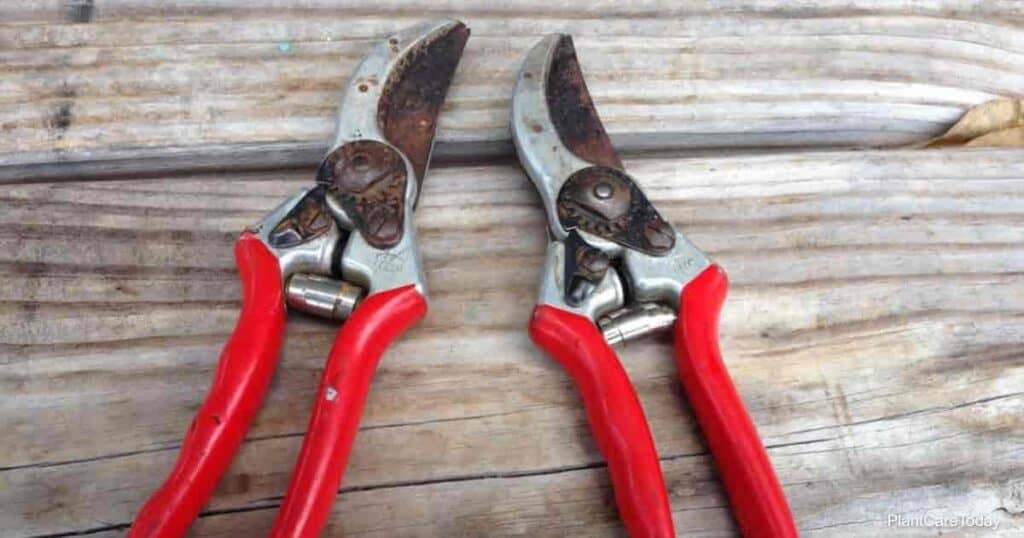[ad_1]
Cleaning your gardening equipment properly after each use is key to preventing the spread of disease and contaminants from one plant to another.
Many home and professional gardeners have questions about how to sterilize pruning shears. Sterilizing your pruning shears and other garden tools is crucial to keeping your plants safe and healthy.
Routine cleaning also helps your equipment operate properly. We’re going to look at the different methods of sterilizing pruning tools.
How to Sterilize Pruning Shears?
You can sterilize pruning shears by soaking, dipping, spraying, or wiping them using a disinfectant. There are different disinfectant types you can use to sterilize your shears. Again, knowing which plant disease you’re dealing with will allow you to get the properly formulated product.
Sterilizing With Disinfectant
There are multiple methods for sterilizing pruning shears, depending on how clean you want them to get. It’s important to rinse your shears and other gardening tools with water after each use, as putting tools away dirty can cause metal surfaces to rust.
But if you’ve been using your tools on sick or a diseased plant, you’ll need to sterilize them using a disinfectant. Water will not remove disease pathogens, which can transfer to healthy plants.
Sterilization can occur in multiple ways, depending on the disinfectant you choose. First, however, it’s crucial to clean your tools before using them again.
Bucket Dip
An easy method to sterilize pruning shears is by filling a bucket with a small amount of disinfectant. Then, carry it with you as you walk through your garden.
After you’ve finished pruning each plant, dip your shears into the solution to clean it. You could also let it soak in the liquid while you’re moving to the next plant.
Sterilizing your pruning shears after pruning each plant reduces the chances of spreading diseases between them. This method is excellent if you know you’ll be working with healthy and diseased plants.
Disinfectant Types
There are commercial plant disinfectant products you can purchase from a store to sanitize your pruning shears. However, there are also multiple solutions you can make yourself with common household ingredients.
Bleach Solution
Bleach is an excellent solution for DIY sterilizing pruning shears. You can use this mixture for a long soak or carry it around for dipping your shears while trimming plants.
Mix one part bleach to nine parts water in a bowl. Then place the blades of your pruning shears into the solution, ensuring the mixture covers all of the metal cutting surface areas.
Some people prefer to submerge the whole tool. After soaking for thirty minutes, rinse with fresh water and then hang them to dry or dry them with paper towels.
The downsides of using bleach are harmful fumes and will eventually damage your shears’ rubber, plastic, and metal parts. It can also damage your clothes and surfaces.
Related: Uses For Hydrogen Peroxide In The Garden
Alcohol
Another household option is to use isopropyl alcohol in a concentration of 70% to 100%. The biggest advantage of using alcohol over other methods is you don’t have to soak your shears in the solution.
The easiest method is to
- Add alcohol into a spray bottle and spray directly onto the shears.
- Put alcohol onto a cloth and wipe the surface or use alcohol wipes.
- Another option is to add alcohol into a bowl and then dip your tool into it.
Although alcohol will kill most pathogens, it produces harmful, smelly fumes and is flammable. Nevertheless, when used appropriately, alcohol is the best disinfectant for sterilizing pruning shears.
Cleaners
You can also use standard household cleaners like PineSol, Lysol, or even Listerine mouthwash to sterilize pruning shears and other garden equipment.
Many experts recommend this method if you don’t have alcohol or bleach on hand, although no scientific data exists to support these claims.
You can use these the same way as alcohol, by spraying, wiping, or soaking. However, long-term use may cause corrosion of your shears.
Pine Oil
Pine oil is another option, but it is not as effective against most disease pathogens. However, it may be useful for sterilizing equipment that has been used on healthy plants.
Combine three parts water with one part pine oil and let your shears soak for thirty minutes. Then rinse and dry with a cloth or by hanging.
Trisodium Phosphates
TSPs are a cheap sterilizer, but it’s highly corrosive since it’s primarily used for cleaning an area before painting.
Mix nine parts water with one part TSP and soak the tools in the solution for three minutes. Try to avoid letting the mixture get on your skin, as it can cause chemical burns.
[ad_2]
Source link











 + Planting String of Watermelon Succulents
+ Planting String of Watermelon Succulents  with Garden Answer
with Garden Answer


